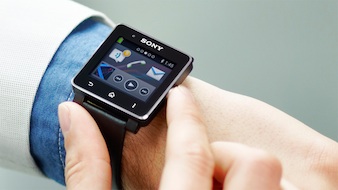With Apple's iWatch and several competing smartwatches from major manufacturers in the works, some analysts question whether such wearable technology will gain popularity among consumers.
The smartwatch market is especially questionable for young people who have moved away from wearing traditional watches and use their smartphones to track the time, analysts said.

Sony's SmartWatch2 enables you to do many of the quick-and-dirty communication and entertainment tasks of a phone.
The most promising uses for smartwatches, initially, could be health-related. A wristband on a smartwatch can monitor the user's blood pressure and heart rate. For instance, contract electronics supplier Foxconn Technology Group last month unveiled a wristband technology that can monitor a user's health and sync with a smartphone, usually through a Bluetooth connection.
Fitness watches are fairly common already. Some can cast an LED light on the skin to get a pulse or monitor whether the wearer is properly hydrated. The next step will be to put sensors used in fitness watches into smartwatches.
Smartwatches may have functions that extend the capabilities of a smartphone. They could, for example, be designed to display alerts of phone calls, texts or tweets -- saving users the trouble of taking their phones out of their pockets, backpacks or handbags.
"It's more discreet to just glance at your wrist and be able to see phone calls, texts or tweets, or other announcements on the face of a watch," said Angela McIntyre, a Gartner analyst who researches wearable technology. "Smartwatches are really acting as peripherals to the smartphone, so that people using them have an alternative screen to the smartphone."
McIntyre envisions adding microphones to smartwatches so they can accept simple commands or be used to make calls. Some prototypes are already designed to respond to incoming tweets with pre-set automatic tweets, she said.
Microsoft is reportedly developing a smartwatch that would run on a modified version of Windows 8 and would have its own LTE data wireless connections, so it wouldn't have to completely rely on a connection to a smartphone.
One potential downside to such a design is that users would need subscriptions to wireless service plans to take advantage of the device's support for LTE connectivity, McIntyre noted. "That's the biggest barrier to having LTE, and why these smartwatches will likely be tethered to another device like a smartphone for connectivity," she said. Still, having cellular technology on a smartwatch could be valuable if the device was used to, say, monitor a person's heart rate and transmit the information to a doctor.
Even if full voice conversations via a smartwatch aren't likely to be feasible for quite a while, McIntyre envisions a market for smartwatches that act as devices to give updates when connected wirelessly to a phone.





